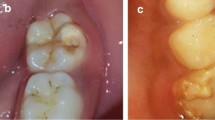Abstract
AIM: To investigate Molar Incisor Hypomineralisation (MIH) in Jordanian children in terms of prevalence, distribution and severity of defects. METHODS: A cross-sectional national study with a representative sample was used. A multistage random sampling system yielded 3,666, 7–9 year-old schoolchildren, from 97 public, private and UNRWA schools from Amman, Irbid and Al-Karak. A questionnaire of six sections was sent to the parents with a consent form to participate in the study. A total of 3,241 children participated resulting in a response rate of 88.4%. A single calibrated investigator examined all children using established criteria for MIH and molar hypomineralisation (MH). Analysis of data was performed with a p value set at 0.05. RESULTS: Of the children examined, 570 (17.6%) were diagnosed with MIH with more females affected than males (53% vs. 47%). The 570 subjects were distributed as MIH cases in 196 children (34.4%) and MH cases in 374 children (65.6%) given that at least one incisor was erupted. Mandibular molars and maxillary central incisors were more frequently affected (p<0.05). No significant difference was found between right and left sides of the mouth. Most defects were mild in severity (44%) and severity increased with age and was related to the number of teeth affected (p<0.05). MIH teeth were more severely affected than MH teeth. CONCLUSIONS: MIH was common among 7–9 year-old Jordanian children with a prevalence of 17.6% and was gender related. MH was more common than MIH and can be considered a mild form of an MIH spectrum. Majority of MIH and MH cases were mild in nature but demonstrated an age-related severity.
Similar content being viewed by others
References
Aine L, Backstrom MC, Maki R, et al. Enamel defects in primary and permanent teeth of children born prematurely. J Oral Pathol Oral Med 2000;29:403–409.
Alaluusua S, Lukinmaa PL, Vartiainen T, et al. Polychlorinated dibenzo-pdioxins and di-benzofurans via mother’s milk may cause development defects in the child’s teeth. Environ Toxicol Pharmacol 1996a;1:193–197.
Alaluusua S, Lukinmaa PL, Koskimies M, et al. Developmental dental defects associated with long breast-feeding. Eur J Oral Sci 1996b;104:493–497.
Arrow P. Prevalence of developmental enamel defects of the first Permanent molars among school children in Western Australia. Aust Dent J 2008;53:250–259.
Calderara PC, Gerthoux PM, Mocarelli P. The prevalence of molar-incisor hypomineralisation in a group of Italian school children. Eur J Peadiatr Dent 2005;2:79–83.
Chawla N, Messer LB, Silva M. Clinical Studies on Molar-Incisor-Hypomineralisation Part 1: Distribution and Putative Associations. Eur Arch Paediatr Dent 2008a;9:180–190.
Chawla N, Messer LB, Silva M. Clinical Studies on Molar-Incisor-Hypomineralisation. Part 2: Development of a Severity Index. Eur Arch Paediatr Dent 2008b;9:191–199.
Cho S, Ki Y, Chu V. Molar incisor hypomineralisation in Hong Kong Chinese children. Int J Paediatr Dent 2008;18:348–352.
He L, Swain V. Enamel-A “metallic-like” deformable biocomposite. J Dent 2007;35:431–437.
Jälevik B, Dietz W, Norén J.G. Scanning electron micrograph analysis of hypomineralised enamel in permanent first molars. Int J Paediatr Dent 2005;15:233–240.
Jälevik B, Klingberg G, Barregard L, Noren JG. The prevalence of demarcated opacities in permanent first molars in a group of Swedish children. Acta Odontol Scand 2001;59:255–260.
Jälevik B, Noren JG. Enamel hypomineralisation of permanent first molars. A morphological study and survey of possible aetiological factors. Int J Paediatr Dent 2000;10:278–289.
Jälevik B, Klingberg GA. Dental treatment, dental fear and behaviour management problems in children with severe enamel hypomineralisation of their permanent first molars. Int J Paediatr Dent 2002;12:24–32.
Jasulaityte L, Veerkamp J.S, Weerheijm K.L. Molar incisor hypomineralisation: review and prevalence data from a study of primary school children in Kaunas. Eur Arch Paediatr Dent 2007;8:87–94.
Koch G, Hallonsten A-L, Ludvigsson N. Epidemiologic study of idiopathic enamel hypomineralisation in permanent teeth of Swedish children. Community Dent Oral Epidemiol 1987;15:279–285.
Kosem R, Senk Erpic A, Kosir N, Kastelec D. Prevalence of enamel defects with emphasis on molar-incisor-hypomineralisation in Slovenian children and adolescents (abstract). Barcelona, Spain. 7th Congress of the EAPD 2004.
Leppaniemi A, Lukinmaa PL, Alaluusua S. Nonfluo¬ride hypomineralisation in the permanent first molars and their impact on the treatment need. Caries Res 2001;35:36–40.
Lygidakis NA, Dimou G, Briseniou E. Molar-Incisor-Hypomineralisation (MIH). Retrospective clinical study in Greek children I. Prevalence and defect characteristics. Eur Arch Paediatr Dent 2008;9:200–206.
Muratbegovic A, Markovic N, Ganibegovic Selimovic M. Molar-incisorhypomineralisation in Bosnia and Herzegovina: etiology and clinical consequences in medium caries activity population. Eur Arch Paediatr Dent 2007;8:189–194.
Nanda RS. Eruption of human teeth. Am J Orthod 1960;46:363–378.
Preusser SE, Ferring V, Wleklinski C, Wetzel WE. Prevalence and severity of molar-incisor-hypomineralisation in a region of Germany — a brief communication. J Public Health Dent 2007;67:148–150.
Weerheijm KL, Jälevik B, Alaluusua S. Molar-incisor hypomineralisation. Caries Res 2001a;35:390–391.
Weerheijm KL, Groen HJ, Beentjes V, Poorterman JHG. Prevalence of cheese molars in eleven year old Dutch children. J Dent Child 2001b;68:259–262.
Weerheijm KL, Mejàre I. Molar incisor hypomineralisation: A questionnaire inventory of its occurrence in member countries of the European Academy of Paediatric Dentistry (EAPD). Int J Paediatr Dent 2003;13:411–416.
Weerheijm KL. Molar Incisor Hypomineralisation. Eur J Oral Science 2003;3:115–120.
Weerheijm KL, Duggal M, Mejare I, et al. Judgement criteria for molar incisor hypomineralisation (MIH) in epidemiologic stud¬ies: a summary of the European meeting on MIH held in Athens, 2003. Eur J Paediatr Dent 2003;4:110–113.
William V, Messer LB, Burrow M. Molar Incisor Hypomineralisation: Review and Recommendations for Clinical Management. Pediatr Dent 2006;28:224–232.
Author information
Authors and Affiliations
Corresponding author
Rights and permissions
About this article
Cite this article
Zawaideh, F.I., Al-Jundi, S.H. & Al-Jaljoli, M.H. Molar Incisor Hypomineralisation: prevalence in Jordanian children and clinical characteristics. Eur Arch Paediatr Dent 12, 31–36 (2011). https://doi.org/10.1007/BF03262776
Published:
Issue Date:
DOI: https://doi.org/10.1007/BF03262776




